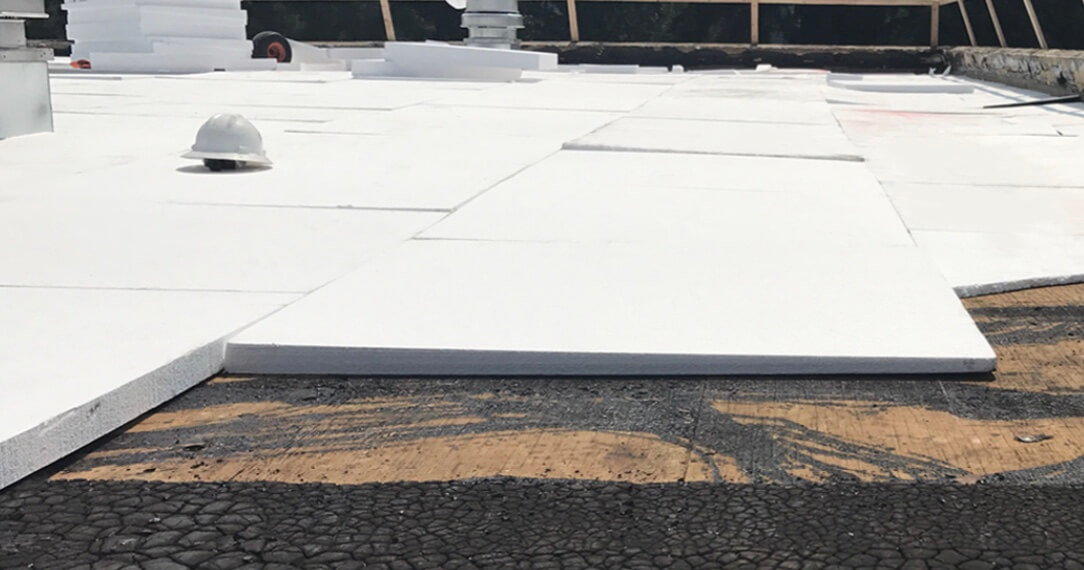
The main purpose of a roof is simple but vital: Protecting your building from nature’s elements. To achieve this, roof assemblies use a variety of waterproofing materials, such as membranes, flashings, and insulation. Among these, insulation is a key player in maintaining your building’s energy efficiency.
Insulation helps prevent heat loss in the winter and heat gain in the summer, improving both the roof system’s functionality and energy savings. But with so many insulation options, how do you know which is best for your flat roof?
At RoofCrafters, we’ve answered this question countless times for clients over the past three decades. If you’re preparing for a flat roof replacement, understanding your insulation options is critical, especially if your roof struggles with issues like ponding water or excessive heat penetration.
In this article, we’ll cover:
- The basics of flat, low-slope, and steep-slope roof construction.
- What R-value means and why it matters.
- The top insulation types for flat roofs.
Let’s start by breaking down the three types of commercial roof construction!
Understanding Roof Construction Types
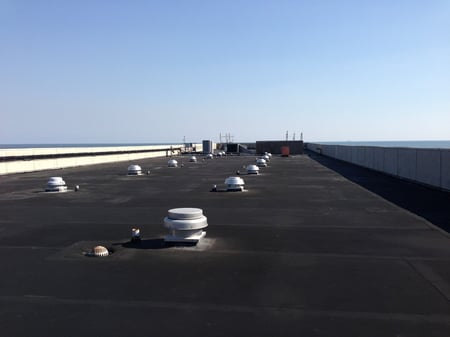
- Flat roof construction
- Low-slope roof construction
- Steep slope roof construction
Flat Roof Construction
Flat roofs are commonly found on commercial buildings, as they provide space for mounting equipment. To ensure water drainage, insulation is used to create a slope. This eliminates ponding water, a requirement by both manufacturers and building codes.
While tapered insulation boosts drainage and R-value, it requires more labor and materials, increasing the project’s overall cost.
Low-Slope Roof Construction
Low-slope roofs have a natural incline that helps water drain. These roofs don’t require tapered insulation and can be insulated from either the attic or the rooftop, depending on the roof deck and system specifications.
However, not all materials are ideal for low-slope roofs. For example, screw-down metal panels (PBR panels) can lead to leaks and maintenance issues on low slopes.
Steep-Slope Roof Construction
Steep-slope commercial roofs are similar to residential roofs, often featuring gable or hip designs. These roofs are typically constructed with trusses or custom wood framing. Insulation is usually installed in the attic or on the underside of the decking.
In cases where there’s no attic space, nail-base or vented nail-base insulation is installed directly under the roof decking. This allows steep-slope roofs to achieve the necessary R-value without traditional insulation methods.
What Is R-Value, and Why Does It Matter?

R-value measures thermal resistance, indicating how well insulation prevents heat transfer. The higher the R-value, the better the insulation.
In roofing, the R-value is determined by combining the insulation, roof deck, and roofing materials. A higher R-value offers several benefits:
- Improved energy efficiency.
- Lower utility bills.
- Reduced strain on HVAC systems.
While higher R-values may increase upfront costs due to thicker or higher-quality insulation, the long-term savings and comfort are well worth it!
What Are the Best Insulation Types for Flat Roofing?
There are many types of insulation used in flat roofing. Oftentimes choosing the right insulation comes down to 3 factors: The deck type, the flat roofing materials being installed, and the desired R-value.
Here are the 7 most frequently used insulation types installed under flat roofs:
- Polyisocyanurate (Polyiso or Iso)
- Expanded polystyrene (EPS)
- Extruded polystyrene (XPS)
- Gypsum board
- Cement Board
- Perlite
- Wood fibered board
Polyisocyanurate Insulation (Polyiso or Iso)
Polyiso is closed-cell insulation. It comes with varying face sheets but the most common in roof assemblies are fiberglass face sheets. It comes in 4-foot by 4-foot sheets or 4-foot by 8-foot sheets in thickness ranging from ½ inch up to 4 inches.
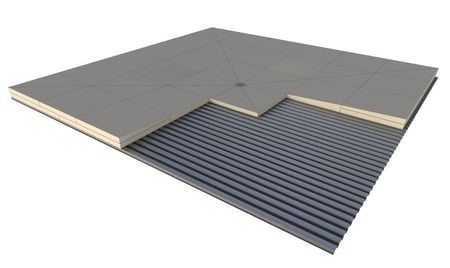
Polyiso is also made in tapered sheets to provide positive water drainage on flat roof assemblies. Tapered sheets come in ⅛ inch per foot, ¼ inch per foot, and ½ inch per foot slopes. Different roof slopes allow contractors flexibility in achieving maximum performance. This is important for water drainage and R-value.
Expanded Polystyrene (EPS)
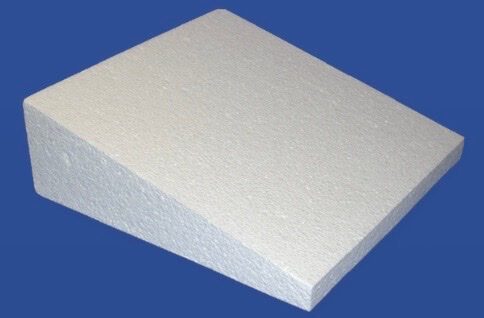
Expanded polystyrene is one of the more cost-effective insulation. Its rigid insulation is commonly used under white single-ply roofing membranes. It has a lower thermal resistance. Therefore to get a higher R-value you may need to combine it with other insulations.
If you are not concerned with increasing the R-value of the roof assembly EPS insulation can be a good option. It's available in various thicknesses of flat 4 ft by 8 ft sheets. EPS also comes in tapered panels to create a slope on flat roof construction.
Extruded Polystyrene (XPS)
XPS is a foam plastic insulation that has low water permeability, therefore it's highly water resistant. It has a higher thermal resistance than EPS insulation. It's commonly used on roof assemblies that have greater exposure to water, such as green roofs, and also under ballast roof systems. It only comes in flat 4 ft by 8 ft sheets. Tapered is not an option.
Gypsum Board
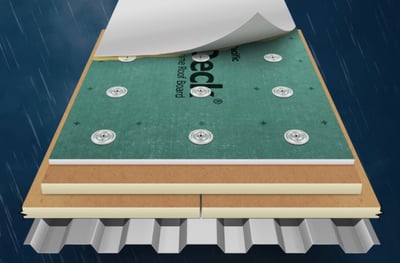
Commonly used in roof assemblies, it’s a gypsum core faced with fiberglass mats. It’s often used to provide a fire-resistance rating. It’s a strong insulation board that also provides wind, hail, and puncture resistance ratings. Typical glass-faced gypsum boards are used with other insulation boards. It's commonly used as a cover board to achieve one of the mentioned ratings.
Cement Board
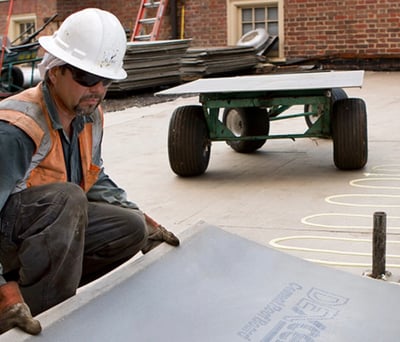
Cement boards are made up of cement and aggregates with fiberglass facings. Because XPS and EPS don’t allow the roof to have a fully adhered roofing membrane. A cement board is commonly used as a cover board with EPS and XPS when the roofing is a fully adhered system.
It is mold, fire, and water resistant. It's used to provide fire resistance over combustible materials. It withstands prolonged moisture. It’ll also provide a high impact rating.
Perlite
Perlite insulation boards are commonly used in conjunction with hot tar and modified bitumen roofing. Perlite is a volcanic glass and is made with wood fibers. It is a rigid insulation board. It comes in flat or tapered boards 4 ft by 4ft. Like the Gypsum and cement board, it is typically used as a cover board to achieve the desired outcome in a roof assembly.
Wood Fibered Board
Woof-fibered boards come in a variety of density strengths. The wood fibered board installed in roof assemblies is density which allows for walkability. Classified as environmentally sustainable. These are completely natural, recyclable, eco-sustainable insulation boards. Similar to gypsum, cement, and perlite it can be used by itself or as a cover board with another insulation.
Ready to Hire a Flat Roof Contractor?
Now that you’ve learned the difference between flat roofs and low-slope roofing. You understand how having a higher R-value will impact your overall energy efficiency. You’ve also learned about the 7 most popular insulation types and their benefits. You’re probably ready to hire a flat roof contractor.
Our team at RoofCrafters Roofing has been helping clients in South Carolina, Georgia, and Florida for nearly 3 decades. We’ve done so by helping them understand which insulation types to use to get the most out of their flat roof investment.
If you're in one of our service areas and would like to speak with one of our flat roof experts, Schedule your inspection today and we'd love to help guide you through your flat roof replacement.
My name is Mitch, and I have over 10 years of roofing experience. I enjoy my career in the service industry because I love helping others take care of their homes and businesses. With over 10 years in the roofing industry, my success comes from my honesty and integrity during my roof inspections. I do my best to listen to the needs of my clients and strive to provide an awesome client experience.



